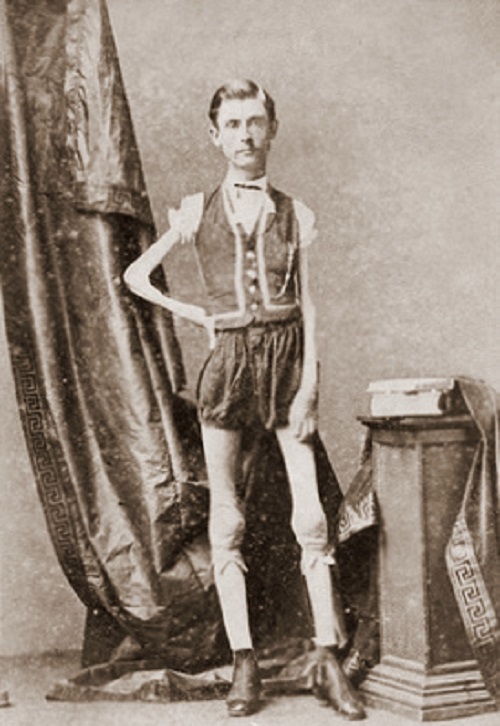Isaac W. Sprague, also known as “The Living Skeleton,” was born on May 21, 1841, in East Bridgewater Massachusetts. He had a normal childhood until his health began deteriorating at age 12. Some early speculation indicated that he may have contracted a bacterial pathogen while swimming, which triggered his subsequent lifelong illness.
Sprague’s disease caused him to be unable to gain weight no matter the nutrients he consumed and he developed progressive muscle wasting and weakness. This combination led to his later famed and exploited skeletal frame in adulthood. It was said that Sprague would always have keep a flask of sugared milk with him at all times to sip on through the day just so he could get steady nutrients so he would not faint or die from starvation. The only official measurement of Sprague was taken by a physician in 1885 when he was 44 years old, where he weighed just 43 pounds at 5 feet 6 inches.
With medical advancements throughout history we now know that Sprague possibly had a rare subtype of a motor neuron disease that affects only the lower motor neurons, known as Progressive Muscular Atrophy or PMA. Symptoms of PMA include atrophy (muscle wasting), muscle twitches, and muscle weakness. The condition has also been called spinal muscular atrophy (SMA), Aran–Duchenne disease, Duchenne–Aran disease, Aran–Duchenne muscular atrophy, and Duchenne–Aran muscular atrophy after Francois Aran, a French neurologist, coined the term in 1850. Guillaume-Benjamin-Amand Duchenne de Bologne claimed to have described the term PMA a year prior, but no statement was ever found. However, his name was still often used as an eponym for the identification of the disease. Aran’s reported patients presented similarly to Sprague, muscle wasting and weakness with slow progression over years to decades with death resulting eventually from complications with the disease.
A proportion of these patients did develop Amyotrophic Lateral Sclerosis (ALS), a progressive neurodegenerative disease that affects nerve cells in the brain and the spinal cord. However, ALS manifests with rapidly progressive muscle weakness and the appearance of upper motor neuron (UMN) signs. PMA is considered a diagnosis of exclusion often found to overlap with ALS but without the UMN signs. According to the American Academy of Neurology, PMA should be considered as a syndromal subtype within a clinical spectrum of motor neuron diseases. It is unclear whether Sprague developed ALS before death, but his symptoms and slow progression of the disease point more to PMA over ALS. He also lived much longer than a patient with ALS would have. Some reports indicate that Sprague lived too long to have either condition and speculate that it is more likely he developed a gastrointestinal issue or twisted bowel in early adolescence that was never able to be fixed. However, multiple doctors examined Sprague and PMA was their official diagnosis at the time when such imaging was unavailable.
Due to his medical condition, Sprague struggled to find steady work and had odd jobs off-and-on as a cobbler and grocer until a carnival promoter spotted him in 1865 when he was 24-years-old and offered him sideshow work. Within a year, Isaac was working for P.T. Barnum, the famed circus mogul, for $80 a day. He began touring as the official “Living Skeleton” or “The Original Thin Man.” Sprague described his first audition with Barnum in a promotional book where he stated “Mr. Barnum stood very near me, and I overhead him say to his agent, “pretty lean man, where did you scare him up?” He worked for Barnum for a few years, both touring the country and inside the famous Barnum’s American Museum in New York City. P.T. Barnum, a well-known name in America to this day, was born in 1810, and is often referred to as the father of show business, and the soul of American capitalism. Barnum’s museum opened for the first time in Jan 1, 1842, in New York City. His sideshow displays consisted of oddities, freaks, performers, and animals and brought in millions of visitors from all over the country. The museum burned to the ground in a spectacular fire in July 1865, but reopened that September. It tragically burned down again in March of 1868. During that year Sprague was working in the museum and narrowly escaped with his life.
Sprague took an early retirement and got married to another Massachusetts native. At 26 he married the then 16-year-old Tamar Moore and they had three healthy sons together, Alphonso DeForest Sprague born in 1868, Lorenzo A. Sprague born in 1870, and Edwin C. Sprague, born in 1872. None of the sons inherited Sprague’s wasting disease and were noted to be healthy boys. 7 On fatherhood, Sprague was noted to have said he finally understood why life was worth living as painful as it was. “Life, that had at times seemed so little worth preserving, now seemed more precious.” Eventually, Sprague had to come out of retirement and return to sideshow work due to dire financial straits and some poor financial decisions. His inability to work a regular job meant returning to show business indefinitely to pay off debts. It was also rumored that he suffered from a serious gambling addiction that he needed to finance as well.
According to an archived New York Times article, Isaac Sprague agreed to donate his body to Harvard Medical College after his death for a thousand dollars. At the time, he was 40 years old and about 40 pounds.
When I die they shall have my body; they will first cut it open and make a post-mortem examination to find out if possible why I am so thin; place it in the museum of the college where it will remain, but I am going to need it for myself for the present; they can’t have it till I get through with it.” … the physicians pronounce it as an extreme case of progressive muscular atrophy. It has been going on for 30 years, while the longest other case on record is that of a man who died after having the complaint for ten years.
Sprague continued touring for Barnum as he aged, but his disease had made him extremely frail and most speculated he would not last long after his 40th birthday. Sprague died of asphyxiation in poverty on January 5, 1887 in Chicago, Illinois. He was 46.
Sprague was one of the most well-known performers in Barnum’s circus and though he was the “Original Thin Man,” many came after him to perform in sideshows and tours billed with the same name as it was an incredibly popular act. The unfortunate effects of Sprague’s illness created a silhouette that appealed to the masses to speculate on and admire. At this time in history, many lives of performers in the circus including Sprague’s and the other “freaks,” were simply exploited due to their physical appearance. Sprague was able to capitalize on his unique look for a time and find employment, eventually having a family and as normal of a life as possible.
Related article: The Boy Born With 2 Percent Of His Brain: A Neurologist’s Perspective
References
- Isaac W. “The Thin Man” Sprague (1841-1887) -… [Internet]. [cited 2019 Mar 1]. Available from: https://www.findagrave.com/memorial/86708388/isaac-w_-sprague
- The True Stories Behind 11 Famous Sideshow Performers [Internet]. 2013 [cited 2019 Mar 1]. Available from: http://mentalfloss.com/article/50078/true-stories-behind-11-famous-sideshow-performers
- Kim W-K, Liu X, Sandner J, Pasmantier M, Andrews J, Rowland LP, et al. Study of 962 patients indicates progressive muscular atrophy is a form of ALS. Neurology [Internet]. 2009 Nov 17 [cited 2019 Mar 1];73(20):1686–92. Available from: https://www.ncbi.nlm.nih.gov/pmc/articles/PMC2788803/
- Aran, F. A. (1850). Recherches sur une maladie non encore décrite du système
musculaire (atrophie musculaire progressive). Arch Gen Med, 24(5), 172. - The history of progressive muscular atrophy | Neurology [Internet]. [cited 2019 Mar 1]. Available from: https://n.neurology.org/content/70/9/723
- Visser J, van den Berg-Vos RM, Franssen H, et al. Disease Course and Prognostic Factors of Progressive Muscular Atrophy. Arch Neurol. 2007;64(4):522–528. doi:10.1001/archneur.64.4.522
- Hartzman M. American Sideshow. Penguin; 2006. 550 p.
- Thompson H. 150 Years Ago, A Fire in P.T. Barnum’s Museum Boiled Two Whales Alive [Internet]. Smithsonian. 2019. Available from: https://www.smithsonianmag.com/smart-news/pt-barnums-bizarre-museum-burned-ground-1865-180955955/
- Number 10.293. The Sun [Internet]. 1865;1. Available from: https://chroniclingamerica.loc.gov/lccn/sn83030272/1865-07-14/ed-1/seq-1/#date1=07%2F13%2F1865&index=1&date2=07%2F20%2F1865&searchType=advanced&language=&sequence=0&words=BARNUM&proxdistance=5&state=New+York&rows=20&ortext=&proxtext=&phrasetext=barnum&andtext=&dateFilterType=range&page=1
- The Living Skeleton.; He Agrees to Give His Body to Harvard Medical College. The New York Times [Internet]. 1883 23;1. Available from: https://www.nytimes.com/1883/12/23/archives/the-living-skeleton-he-agrees-to-give-his-body-to-harvard-medical.html
- Death of the Living Skeleton. The New York Times [Internet]. 1887 Jan 6;1. Available from: https://www.nytimes.com/1887/01/07/archives/death-of-the-living-skeleton.html





